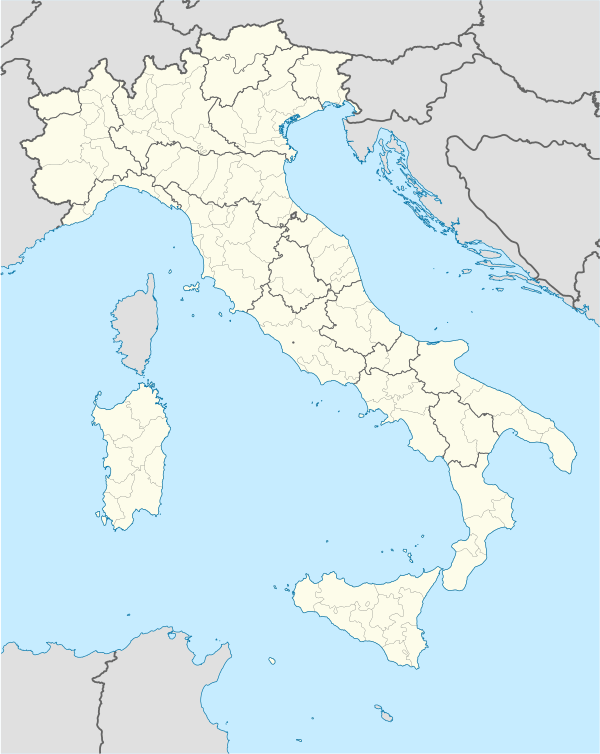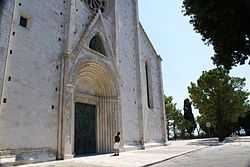Fermo
| Fermo | ||
|---|---|---|
| Comune | ||
| Città di Fermo | ||
|
Panorama of Fermo. | ||
| ||
 Fermo Location of Fermo in Italy | ||
| Coordinates: 43°09′39″N 13°42′57″E / 43.16083°N 13.71583°ECoordinates: 43°09′39″N 13°42′57″E / 43.16083°N 13.71583°E | ||
| Country | Italy | |
| Region | Marche | |
| Province | Province of Fermo (FM) | |
| Frazioni | see list | |
| Government | ||
| • Mayor | Nella Brambatti (PD) | |
| Area | ||
| • Total | 124 km2 (48 sq mi) | |
| Elevation | 319 m (1,047 ft) | |
| Population (31 December 2007) | ||
| • Total | 37,760 | |
| • Density | 300/km2 (790/sq mi) | |
| Demonym | Fermani | |
| Time zone | CET (UTC+1) | |
| • Summer (DST) | CEST (UTC+2) | |
| Postal code | 63023 | |
| Dialing code | 0734 | |
| Patron saint | St. Maria Assunta | |
| Saint day | August 15 | |
| Website | Official website | |
Fermo ![]() listen (ancient: Firmum Picenum) is a town and comune of the Marche, Italy, in the Province of Fermo.
listen (ancient: Firmum Picenum) is a town and comune of the Marche, Italy, in the Province of Fermo.
Fermo is on a hill, the Sabulo, elevation 319 metres (1,047 ft), on a branch from Porto San Giorgio on the Adriatic coast railway.[1]
History
The great antiquity of the city is attested by the remains of its cyclopean walls. The ancient Firmum Picenum was founded as a Latin colony, consisting of 6000 men, in 264 BC, after the conquest of the Picentes, as the local headquarters of the Roman power, to which it remained faithful. It was originally governed by five quaestors. It was made a colony with full rights after the battle of Philippi, the 4th Legion being settled there. It lay at the junction of roads to Pausulae, Urbs Salvia, and Asculum, connected to the coast road by a short branch road from Castellum Firmanum (Porto S. Giorgio).[1]
With the Pentapolis, in the 8th century it passed under the authority of the Holy See was thenceforth subject to the vicissitudes of the March of Ancona.[2] In the 10th century it became the capital of the Marchia Firmana.[1] Under the predecessors of Honorius III (1216–27) the bishops of city became prince-bishops, first with the secular rights of counts, and later as princes of Fermo.[2]
In 1199 it became a free city, and remained independent until 1550, when it was annexed to the Papal States.[1]
In the contest between the Hohenstaufen and the papacy, Fermo was besieged and captured several times; in 1176 by Archbishop Christian of Mainz, in 1192 by Emperor Henry Vl, in 1208 by Marcuald, Duke of Ravenna, in 1241 by Emperor Frederick II, and in 1245 by Manfred of Sicily. After this it was governed by different lords, who ruled as more or less legitimate vassals of the Holy See, e.g. the Monteverdi, Giovanni Visconti and Francesco Sforza (banished 1446), Oliverotto Euffreducci (murdered in 1503 by Cesare Borgia), who was succeeded by his son Ludovico, killed at the battle of Montegiorgio in 1520, when Fermo became again directly subjected to the Holy See.[2]
Fermo is now the capital city of the new province of Fermo, effective since 2009.
Attractions
- The cathedral, reconstructed in 1227 by Giorgio da Como, has a Gothic facade made of Istrian stone, divided by light pilasters and with a central rose window (1348), a bell tower from the same age, and a side portal. The rose-window over the main door dates from 1348. In the vestibule are several tombs, including one from 1366 by Tura da Imola, and also the modern monument to Giuseppe Colucci, a famous writer on the antiquities of Picenum. The interior has been modernized, in particular after its destruction by Christian of Mainz in 1176 by order of Frederick Barbarossa. The building is now surrounded by a garden.[1] Excavations undertaken in 1934–35 under the church's pavement brought to light remains from the age of Antoninus Pius (2nd century AD) and of a Palaeo-Christian basilica dating to the 6th century AD. This had three naves divided into four bays, with a raised presbytery. Of its mosaic decorations today only those in the apse are visible, depicting two peacocks near a kantharos surmounted by the chrismon, two typical examples of art in Ravenna at the time. Among the possessions of the treasury of the Cathedral is a chasuble said to have belonged to St. Thomas Becket, murdered in Canterbury on 1170 and canonized by Pope Alexander II on 1173. It is said to have been given to ferno by Bishop Presbitero (1184–1203).
 The cathedral of Fermo in the Marche Region of Italy
The cathedral of Fermo in the Marche Region of Italy - The Roman theater; scant traces of an amphitheater also exist. Remains of the city wall, of rectangular blocks of hard limestone, may be seen just outside the Porta S. Francesco; whether the walling under the Casa Porti belongs to them is doubtful. The medieval embattled walls superposed on it are picturesque.[1]
- The cisterns of Fermo are an archaeological site situated on top of the hill, at 310 metres (1,020 ft) above sea level. Fermo boasts one of the most gigantic and well-preserved example of Roman cisterns in Italy. They have been built around 1st century a.C. The structure is a rectangular construction of about 30 by 70 metres (98 by 230 ft) consisting of 30 underground rooms: they provided water for the city probably through public fountains. The underground pipe network above the cisterns was connected to a canal around the external walls. From the canal, small pipes brought water into the cisterns: water inlets are still visible inside the rooms. The cisterns are made of Opus caementicium which is the waterproofing old Roman concrete. The level of the water inside the rooms was about 70 centimetres (28 in) and the total amount of water inside was about 3000 mq.[3]
 cisterns of Fermo
cisterns of Fermo - The Church of Saint Francis has a good tower and choir in brickwork of 1240, the rest having been restored in the 17th century.[1]
- The Palazzo dei Priori, restored in 1446, with a statue of Pope Sixtus V in front of it. The Biblioteca Comunale contains a collection of inscriptions and antiquities.[1]
The near municipality of Porto San Giorgio has a fine castle of 1269, blocking the valley that leads to Fermo.[1]
Frazioni
Camera, Cantagallo, Capodarco, Cartiera di Tenna, Campiglione, Ete Palazzina, Faleriense, Gabbiano, Girola, Lido di Fermo, Madonnetta d'Ete, Marina Palmense, Moie, Molini Tenna, Montesecco, Parete, Pompeiana, Ponte Ete Vivo, Sacri Cuori, Salette, Salvano, San Biagio, San Lorenzo, San Marco, San Michele, San Tommaso, Santa Caterina, Torre di Palme, Villa San Claudio
Twin towns
-
 Berat, Albania
Berat, Albania -
 Bahía Blanca, Argentina
Bahía Blanca, Argentina -
 Weihai, People's Republic of China
Weihai, People's Republic of China -
 Ansbach, Germany, since 2006
Ansbach, Germany, since 2006 -
 León, Mexico
León, Mexico
Notable people
- Blessed John of Fermo (Fermo, 1259 – La Verna in Tuscany, 10 August 1322), more often called John of La Verna
- Fermo is the birthplace of poet Annibale Caro (June 6, 1507 - November 17, 1566).
- Decio Azzolino (April 11, 1623 – June 8, 1689) - Italian cardinal, Vatican code-breaker, close friend of Christina, Queen of Sweden
- Operatic baritone Francesco Graziani (April 26, 1828 – June 30, 1901) was born in Fermo and also died there in 1901.
- Celebrated physician and University teacher Augusto Murri (Fermo, Italy, 8 September 1841; d. Bologna, Italy, 11 November 1932)
- Master violin maker Andreas Postacchini (searching for BD/DD but best works are late 18th to mid-19th century)
See also
Notes
References
- Attribution
-
 This article incorporates text from a publication now in the public domain: Ashby, Thomas (1911). "Fermo". In Chisholm, Hugh. Encyclopædia Britannica 10 (11th ed.). Cambridge University Press. p. 278.
This article incorporates text from a publication now in the public domain: Ashby, Thomas (1911). "Fermo". In Chisholm, Hugh. Encyclopædia Britannica 10 (11th ed.). Cambridge University Press. p. 278. -
 This article incorporates text from a publication now in the public domain: Benigni, U. (1909). "Archdiocese of Fermo". In Herbermann, Charles. Catholic Encyclopedia 6. Robert Appleton Company.
This article incorporates text from a publication now in the public domain: Benigni, U. (1909). "Archdiocese of Fermo". In Herbermann, Charles. Catholic Encyclopedia 6. Robert Appleton Company.
External links
| Wikimedia Commons has media related to Fermo. |

